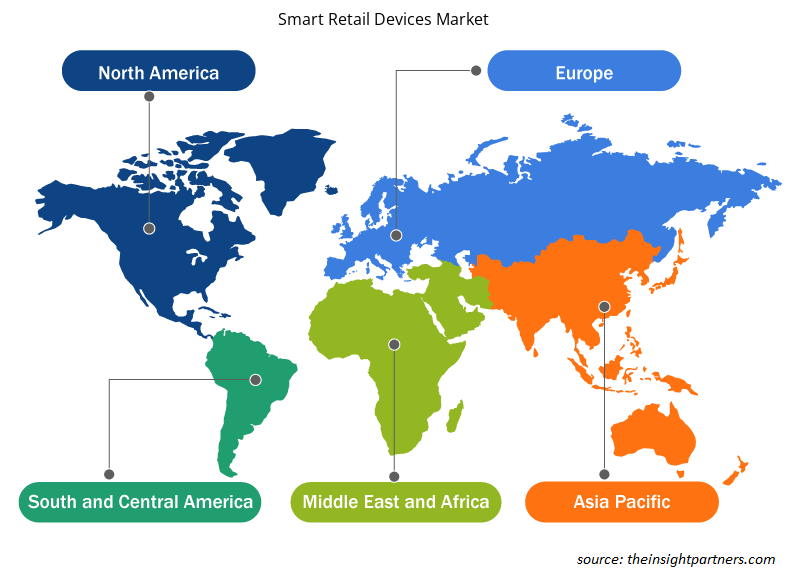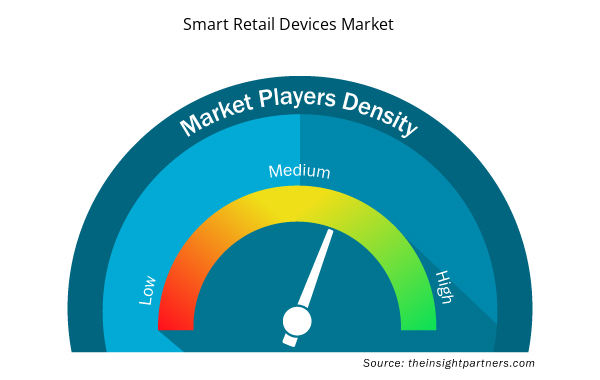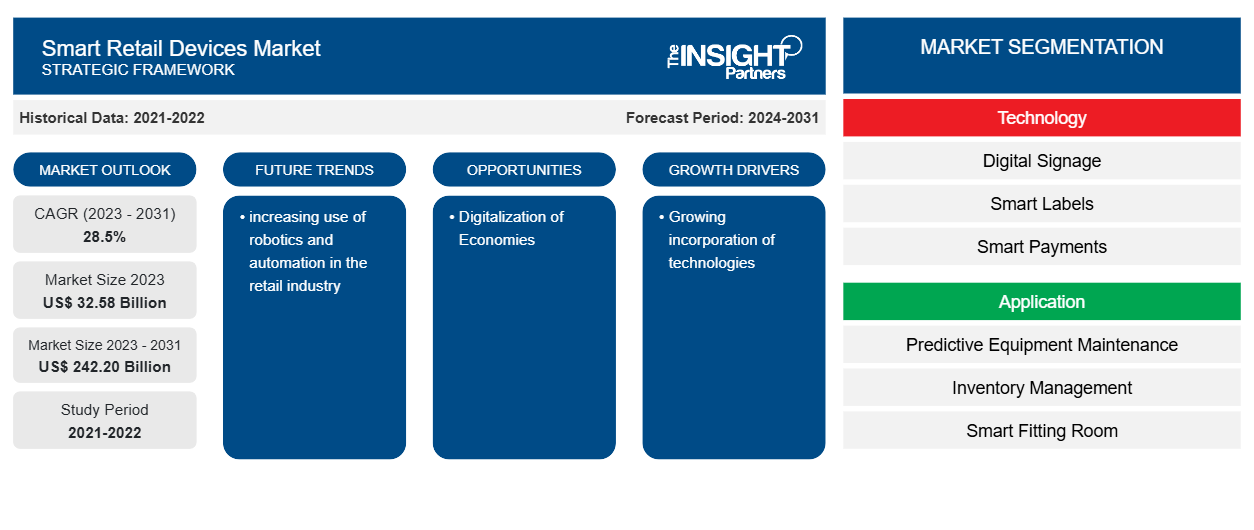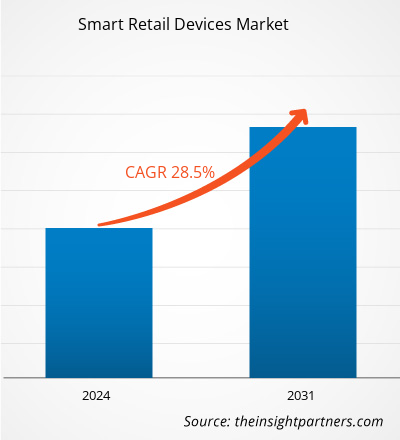من المتوقع أن ينمو حجم سوق أجهزة البيع بالتجزئة الذكية من 32.58 مليار دولار أمريكي في عام 2023 إلى 242.20 مليار دولار أمريكي بحلول عام 2031؛ ومن المتوقع أن يتوسع بمعدل نمو سنوي مركب قدره 28.5٪ من عام 2024 إلى عام 2031. ومن المرجح أن يظل الاستخدام المتزايد للروبوتات والأتمتة في صناعة البيع بالتجزئة أحد الاتجاهات الرئيسية في سوق أجهزة البيع بالتجزئة الذكية.
تحليل سوق أجهزة البيع بالتجزئة الذكية
إن الاعتماد المتزايد على تحليلات البيانات الضخمة وإنترنت الأشياء (IoT) في قطاع البيع بالتجزئة إلى جانب الارتفاع الكبير في القدرة الشرائية للمستهلكين هي العوامل المحركة الرئيسية لسوق أجهزة البيع بالتجزئة الذكية.
نظرة عامة على سوق أجهزة البيع بالتجزئة الذكية
إن البيع بالتجزئة الذكي هو استخدام التكنولوجيا والبيانات لتحسين تجارب التسوق للعملاء وعمليات الشركات. تسمح هذه التقنيات للمؤسسات بتحسين تجربة العملاء وتبسيط الإجراءات والحصول على رؤى مهمة حول سلوك المستهلك. تتيح هذه الأدوات المتصلة بالإنترنت للمستخدمين الوصول بسهولة إلى المعلومات والخدمات المخصصة، في حين تجعل القدرات المتطورة مثل التعرف على الكلام وتكامل لوحة اللمس التسوق أمرًا سهلاً، مع وجود مساعدين افتراضيين يقودون المستهلكين إلى اختيار السلع المناسبة ، وتصفح الصفقات المثيرة للاهتمام، وإجراء عمليات الشراء، وحتى التقاط التجارب ومشاركتها على وسائل التواصل الاجتماعي.
قم بتخصيص هذا التقرير ليناسب متطلباتك
ستحصل على تخصيص لأي تقرير - مجانًا - بما في ذلك أجزاء من هذا التقرير، أو تحليل على مستوى الدولة، وحزمة بيانات Excel، بالإضافة إلى الاستفادة من العروض والخصومات الرائعة للشركات الناشئة والجامعات
- احصل على أهم اتجاهات السوق الرئيسية لهذا التقرير.ستتضمن هذه العينة المجانية تحليلاً للبيانات، بدءًا من اتجاهات السوق وحتى التقديرات والتوقعات.
محركات وفرص سوق أجهزة البيع بالتجزئة الذكية
تزايد دمج التكنولوجيا لصالح السوق
يتم استخدام دمج التقنيات مثل الذكاء الاصطناعي والواقع الافتراضي والواقع المعزز وإنترنت الأشياء بشكل متزايد في صناعة التجزئة لتحسين تجربة التسوق وتحسين إدارة المخزون وتبسيط عمليات المتجر. يعد إنترنت الأشياء مكونًا مهمًا في بيئة البيع بالتجزئة الذكية لأنه يربط الأدوات بالإنترنت ويقدم بيانات حيوية عن سلوك العملاء وعمليات المتجر وإدارة المخزون. تمكن أجهزة إنترنت الأشياء، مثل أجهزة الاستشعار والمنارات، التجار من جمع البيانات في الوقت الفعلي حول مستويات المخزون وتدفق العملاء وأصول المتجر، مما يسمح لهم باتخاذ قرارات أكثر استنارة وتحسين العمليات.
رقمنة الاقتصادات
يوفر استخدام الرقمنة العديد من الفوائد للمتاجر، بما في ذلك اكتساب مستهلكين جدد وخفض تكاليف التشغيل. بالإضافة إلى ذلك، تتمتع الرقمنة بالقدرة على تشجيع موظفي التجزئة بشكل كبير. ونتيجة لذلك، قد يشهد تجار التجزئة زيادة في إيراداتهم. والجدير بالذكر أن التسوق خارج المتاجر شهد نموًا كبيرًا في عام 2020. ومن المرجح أن تستفيد منافذ البيع بالتجزئة عبر الإنترنت بشكل كبير من التحسينات التكنولوجية، وزيادة الاتصال، وإدخال أجهزة استشعار جديدة، وتوافر حلول اتصال سلسة ، وبالتالي المساهمة بشكل كبير في نمو السوق طوال فترة التوقعات.
تقرير تحليل تجزئة سوق أجهزة البيع بالتجزئة الذكية
إن القطاعات الرئيسية التي ساهمت في اشتقاق تحليل سوق أجهزة البيع بالتجزئة الذكية هي التكنولوجيا والتطبيق.
- بناءً على التكنولوجيا، ينقسم السوق إلى لافتات رقمية، وملصقات ذكية، ومدفوعات ذكية، وعربات ذكية، وغيرها. احتل قطاع اللافتات الرقمية حصة سوقية أكبر في عام 2023.
- من حيث التطبيق، ينقسم السوق إلى صيانة المعدات التنبؤية، وإدارة المخزون، وغرفة القياس الذكية، ومراقبة حركة المشاة وغيرها. احتل قطاع إدارة المخزون حصة سوقية أكبر في عام 2023.
تحليل حصة سوق أجهزة البيع بالتجزئة الذكية حسب المنطقة الجغرافية
ينقسم النطاق الجغرافي لتقرير سوق أجهزة البيع بالتجزئة الذكية بشكل أساسي إلى خمس مناطق: أمريكا الشمالية، ومنطقة آسيا والمحيط الهادئ، وأوروبا، والشرق الأوسط وأفريقيا، وأمريكا الجنوبية/أمريكا الجنوبية والوسطى. سيطرت أمريكا الشمالية على سوق أجهزة البيع بالتجزئة الذكية في عام 2023. ومن المتوقع أن تكون هذه المنطقة هي أكبر مصدر للإيرادات في السوق خلال الإطار الزمني المتوقع بالكامل. إن الرغبة المتزايدة في المنتجات الفاخرة الراقية، إلى جانب التحولات الديناميكية في تفضيلات العملاء نحو تجارب البيع بالتجزئة الأكثر ملاءمة وكفاءة في الوقت، هي عوامل رئيسية تدفع هذا الاتجاه. علاوة على ذلك، فإن التكامل الواسع النطاق للتكنولوجيا الرقمية عبر مختلف القطاعات يعيد تشكيل الاقتصاد الأمريكي. لقد أدت عواقب الوباء إلى تسريع التحول الرقمي للشركات داخل صناعة التجزئة بشكل كبير، متجاوزة التوقعات السابقة.
رؤى إقليمية حول سوق أجهزة البيع بالتجزئة الذكية
لقد قام المحللون في Insight Partners بشرح الاتجاهات والعوامل الإقليمية المؤثرة على سوق أجهزة البيع بالتجزئة الذكية طوال فترة التوقعات بشكل شامل. يناقش هذا القسم أيضًا قطاعات سوق أجهزة البيع بالتجزئة الذكية والجغرافيا في جميع أنحاء أمريكا الشمالية وأوروبا ومنطقة آسيا والمحيط الهادئ والشرق الأوسط وأفريقيا وأمريكا الجنوبية والوسطى.

- احصل على البيانات الإقليمية المحددة لسوق أجهزة البيع بالتجزئة الذكية
نطاق تقرير سوق أجهزة البيع بالتجزئة الذكية
| سمة التقرير | تفاصيل |
|---|---|
| حجم السوق في عام 2023 | 32.58 مليار دولار أمريكي |
| حجم السوق بحلول عام 2031 | 242.20 مليار دولار أمريكي |
| معدل النمو السنوي المركب العالمي (2023 - 2031) | 28.5% |
| البيانات التاريخية | 2021-2022 |
| فترة التنبؤ | 2024-2031 |
| القطاعات المغطاة | حسب التكنولوجيا
|
| المناطق والدول المغطاة | أمريكا الشمالية
|
| قادة السوق وملفات تعريف الشركات الرئيسية |
|
كثافة اللاعبين في سوق أجهزة البيع بالتجزئة الذكية: فهم تأثيرها على ديناميكيات الأعمال
يشهد سوق أجهزة البيع بالتجزئة الذكية نموًا سريعًا، مدفوعًا بالطلب المتزايد من المستخدم النهائي بسبب عوامل مثل تفضيلات المستهلكين المتطورة والتقدم التكنولوجي والوعي المتزايد بفوائد المنتج. ومع ارتفاع الطلب، تعمل الشركات على توسيع عروضها والابتكار لتلبية احتياجات المستهلكين والاستفادة من الاتجاهات الناشئة، مما يؤدي إلى زيادة نمو السوق.
تشير كثافة اللاعبين في السوق إلى توزيع الشركات أو المؤسسات العاملة في سوق أو صناعة معينة. وهي تشير إلى عدد المنافسين (اللاعبين في السوق) الموجودين في مساحة سوق معينة نسبة إلى حجمها أو قيمتها السوقية الإجمالية.
الشركات الرئيسية العاملة في سوق أجهزة البيع بالتجزئة الذكية هي:
- شركة إنتل
- مجموعة سامسونج
- شركة NVIDIA
- إل جي إلكترونيكس
- شركة زيبرا تكنولوجيز
- شركة كابر
إخلاء المسؤولية : الشركات المذكورة أعلاه ليست مرتبة بأي ترتيب معين.

- احصل على نظرة عامة على أهم اللاعبين الرئيسيين في سوق أجهزة البيع بالتجزئة الذكية
أخبار سوق أجهزة البيع بالتجزئة الذكية والتطورات الأخيرة
يتم تقييم سوق أجهزة البيع بالتجزئة الذكية من خلال جمع البيانات النوعية والكمية بعد البحث الأولي والثانوي، والتي تتضمن منشورات الشركات المهمة وبيانات الجمعيات وقواعد البيانات. فيما يلي قائمة بالتطورات في السوق:
- في يونيو 2023، تعاونت إنتل وفيريكاست لتطوير وتنفيذ وتقييم شبكة وسائط رقمية متطورة قابلة للبرمجة للبيع بالتجزئة داخل المتاجر. يستفيد هذا النظام المبتكر من تكنولوجيا الاستهداف المتقدمة من فيريكاست ومنصات البرامج القوية من إنتل لتقديم إعلانات مخصصة وتفاصيل المنتج التي تتوافق مع رحلة تسوق العميل. يعد هذا التعاون عنصرًا أساسيًا في مبادرتنا الأوسع لإحداث ثورة في صناعة التجزئة والاستفادة من التحول الرقمي للمتاجر المادية، والذي يُنظر إليه على نطاق واسع باعتباره الاتجاه الرئيسي التالي في قطاع الإعلان.
(المصدر: إنتل، بيان صحفي، 2023)
- في نوفمبر 2023، قدمت شركة Panasonic Connect Europe حلاً جديدًا مدعومًا بالذكاء الاصطناعي يهدف إلى تحويل صناعة التجزئة من خلال تخصيص الإعلانات من خلال مساعدي الذكاء الاصطناعي المولدين للعملاء أثناء التسوق. يتيح هذا الحل المبتكر للمتاجر مراقبة التركيبة السكانية للمتسوقين تلقائيًا والجمع بين هذه المعلومات وتفضيلات الشراء وبيانات الطقس والأحداث المحلية لتخصيص الإعلانات على شاشات العرض داخل المتجر على الفور. دخلت شركة Panasonic في شراكة مع ADEAL Systems، وهي شركة رائدة في مجال البيانات والذكاء الاصطناعي، لدمج مساعد التسوق الشخصي المدعوم بالذكاء الاصطناعي، CUSAAS (تقسيم العملاء كخدمة)، مع حلول الكاميرات والشاشات ذات التكنولوجيا المتطورة للبيع بالتجزئة، مما يخلق تجربة تسوق محسنة.
(المصدر: باناسونيك، بيان صحفي، 2023)
تقرير سوق أجهزة البيع بالتجزئة الذكية: التغطية والنتائج المتوقعة
يوفر تقرير "حجم سوق أجهزة البيع بالتجزئة الذكية والتوقعات (2021-2031)" تحليلاً مفصلاً للسوق يغطي المجالات التالية:
- حجم السوق والتوقعات على المستويات العالمية والإقليمية والوطنية لجميع قطاعات السوق الرئيسية التي يغطيها النطاق
- ديناميكيات السوق مثل المحركات والقيود والفرص الرئيسية
- الاتجاهات المستقبلية الرئيسية
- تحليل مفصل لقوى PEST/Porter الخمس وSWOT
- تحليل السوق العالمي والإقليمي الذي يغطي اتجاهات السوق الرئيسية واللاعبين الرئيسيين واللوائح والتطورات الأخيرة في السوق
- تحليل المشهد الصناعي والمنافسة الذي يغطي تركيز السوق، وتحليل خريطة الحرارة، واللاعبين البارزين، والتطورات الأخيرة
- ملفات تعريف الشركة التفصيلية
- التحليل التاريخي (سنتان)، السنة الأساسية، التوقعات (7 سنوات) مع معدل النمو السنوي المركب
- تحليل PEST و SWOT
- حجم السوق والقيمة / الحجم - عالميًا وإقليميًا وقطريًا
- الصناعة والمنافسة
- مجموعة بيانات Excel



Report Coverage
Revenue forecast, Company Analysis, Industry landscape, Growth factors, and Trends

Segment Covered
This text is related
to segments covered.

Regional Scope
North America, Europe, Asia Pacific, Middle East & Africa, South & Central America

Country Scope
This text is related
to country scope.
الأسئلة الشائعة
The smart retail devices market size is expected to grow from US$ 32.58 billion in 2023 to US$ 242.20 billion by 2031; it is anticipated to expand at a CAGR of 28.5% from 2024 to 2031.
The rising adoption of big data analytics and the Internet of Things (IoT) in the retail industry, the surge in purchasing power of consumers and economic growth are major driving factors for the smart retail devices market.
The increasing use of robotics and automation in the retail industry is likely to remain a key smart retail devices market trends.
The key players holding the majority of shares in the global smart retail devices market are DronaHQ, Salesforce, Thunkable, Inc., WaveMaker, Inc., and Zoho Corporation.
The global smart retail devices market is expected to reach US$ 242.20 billion by 2031.
Trends and growth analysis reports related to Electronics and Semiconductor : READ MORE..
The Insight Partners performs research in 4 major stages: Data Collection & Secondary Research, Primary Research, Data Analysis and Data Triangulation & Final Review.
- Data Collection and Secondary Research:
As a market research and consulting firm operating from a decade, we have published and advised several client across the globe. First step for any study will start with an assessment of currently available data and insights from existing reports. Further, historical and current market information is collected from Investor Presentations, Annual Reports, SEC Filings, etc., and other information related to company’s performance and market positioning are gathered from Paid Databases (Factiva, Hoovers, and Reuters) and various other publications available in public domain.
Several associations trade associates, technical forums, institutes, societies and organization are accessed to gain technical as well as market related insights through their publications such as research papers, blogs and press releases related to the studies are referred to get cues about the market. Further, white papers, journals, magazines, and other news articles published in last 3 years are scrutinized and analyzed to understand the current market trends.
- Primary Research:
The primarily interview analysis comprise of data obtained from industry participants interview and answers to survey questions gathered by in-house primary team.
For primary research, interviews are conducted with industry experts/CEOs/Marketing Managers/VPs/Subject Matter Experts from both demand and supply side to get a 360-degree view of the market. The primary team conducts several interviews based on the complexity of the markets to understand the various market trends and dynamics which makes research more credible and precise.
A typical research interview fulfils the following functions:
- Provides first-hand information on the market size, market trends, growth trends, competitive landscape, and outlook
- Validates and strengthens in-house secondary research findings
- Develops the analysis team’s expertise and market understanding
Primary research involves email interactions and telephone interviews for each market, category, segment, and sub-segment across geographies. The participants who typically take part in such a process include, but are not limited to:
- Industry participants: VPs, business development managers, market intelligence managers and national sales managers
- Outside experts: Valuation experts, research analysts and key opinion leaders specializing in the electronics and semiconductor industry.
Below is the breakup of our primary respondents by company, designation, and region:

Once we receive the confirmation from primary research sources or primary respondents, we finalize the base year market estimation and forecast the data as per the macroeconomic and microeconomic factors assessed during data collection.
- Data Analysis:
Once data is validated through both secondary as well as primary respondents, we finalize the market estimations by hypothesis formulation and factor analysis at regional and country level.
- Macro-Economic Factor Analysis:
We analyse macroeconomic indicators such the gross domestic product (GDP), increase in the demand for goods and services across industries, technological advancement, regional economic growth, governmental policies, the influence of COVID-19, PEST analysis, and other aspects. This analysis aids in setting benchmarks for various nations/regions and approximating market splits. Additionally, the general trend of the aforementioned components aid in determining the market's development possibilities.
- Country Level Data:
Various factors that are especially aligned to the country are taken into account to determine the market size for a certain area and country, including the presence of vendors, such as headquarters and offices, the country's GDP, demand patterns, and industry growth. To comprehend the market dynamics for the nation, a number of growth variables, inhibitors, application areas, and current market trends are researched. The aforementioned elements aid in determining the country's overall market's growth potential.
- Company Profile:
The “Table of Contents” is formulated by listing and analyzing more than 25 - 30 companies operating in the market ecosystem across geographies. However, we profile only 10 companies as a standard practice in our syndicate reports. These 10 companies comprise leading, emerging, and regional players. Nonetheless, our analysis is not restricted to the 10 listed companies, we also analyze other companies present in the market to develop a holistic view and understand the prevailing trends. The “Company Profiles” section in the report covers key facts, business description, products & services, financial information, SWOT analysis, and key developments. The financial information presented is extracted from the annual reports and official documents of the publicly listed companies. Upon collecting the information for the sections of respective companies, we verify them via various primary sources and then compile the data in respective company profiles. The company level information helps us in deriving the base number as well as in forecasting the market size.
- Developing Base Number:
Aggregation of sales statistics (2020-2022) and macro-economic factor, and other secondary and primary research insights are utilized to arrive at base number and related market shares for 2022. The data gaps are identified in this step and relevant market data is analyzed, collected from paid primary interviews or databases. On finalizing the base year market size, forecasts are developed on the basis of macro-economic, industry and market growth factors and company level analysis.
- Data Triangulation and Final Review:
The market findings and base year market size calculations are validated from supply as well as demand side. Demand side validations are based on macro-economic factor analysis and benchmarks for respective regions and countries. In case of supply side validations, revenues of major companies are estimated (in case not available) based on industry benchmark, approximate number of employees, product portfolio, and primary interviews revenues are gathered. Further revenue from target product/service segment is assessed to avoid overshooting of market statistics. In case of heavy deviations between supply and demand side values, all thes steps are repeated to achieve synchronization.
We follow an iterative model, wherein we share our research findings with Subject Matter Experts (SME’s) and Key Opinion Leaders (KOLs) until consensus view of the market is not formulated – this model negates any drastic deviation in the opinions of experts. Only validated and universally acceptable research findings are quoted in our reports.
We have important check points that we use to validate our research findings – which we call – data triangulation, where we validate the information, we generate from secondary sources with primary interviews and then we re-validate with our internal data bases and Subject matter experts. This comprehensive model enables us to deliver high quality, reliable data in shortest possible time.


 احصل على عينة مجانية لهذا التقرير
احصل على عينة مجانية لهذا التقرير